$2M+ of lies to win power

I believe in truth in advertising. So does the commercial TV regulator that demands evidence for any claim you want to make before they give your ad clearance to air. Unfortunately for the voters of NSW, political parties are allowed to say what they want in an ad because they aren't answerable to any of the rules mere brands and businesses have to conform to.
If I made a fraudulent claim for a client in an ad, (for instance the kind of price saving offer mobile phone plans were notorious for before being fined into transparent pricing), the ACCC or ASIC would come after me. This election has seen Labor and unions spend twice the Liberals. Most of that $2,500,000 was on ads that say electricity prices will go up if Baird sells 49% of the poles and wires. It's a lie.
Their ads scream this lie despite ACCC chairman Rod Simms saying this isn't the case. Even the Australian Energy regulator is on record that whoever owns the poles and wires in NSW after the election he will insist they reduce their prices by 20-30% over the next five years. There is no evidence for the claim made in Labor's ads that I believe would have satisfied the broadcast standards that commercial advertisers have to comply with. In fact, there is much historic evidence from previous power privatisations showing prices are lower outside government ownership. This has been acknowledged by such Labor luminaries as Bob Carr, Morris Iemma, Michael Costa and Anna Bligh when they attempted to sell the poles and wires under their governments.
It frustrates me as a professional marketer that in the 21st century political parties of any persuasion can play 1984 mind games with the truth and run them in prime time. The ABC Fact Check merely called Foley's ad pitch "spin". I prefer the robust language of former Labor Energy Minister and ACTU president Martin Ferguson. He says Foley's spin is "rank opportunism and scaremongering... sending a clear message he doesn't care about jobs and energy security."
Politicians' ad claims are officially accountable to... themselves
Here is the law (or lack of) that applies to political advertising as published by adstandards:
"Currently, there is no legal requirement for the content of political advertising to be factually correct. Complainants are advised to raise their concerns with the advertiser directly and/or with their local Member of Parliament."
Maybe we should just ban political advertising, we banned cigarette ads for telling us porkies.
Read MoreThe optimum lengths of social media
People now have short attention spans. So to connect you have to cut through. Keep it honest. Keep it simple. And keep it true to your brand. As for length, keep it short.
71 - 100 characters
Posts with 40 characters get 86% more engagement
Google+
25 characters
40 characters
Linked In
Posts 16 to 25 words long
Videos
Average length watched is 2.7 minutes
Read MoreThe average customer has an attention span of

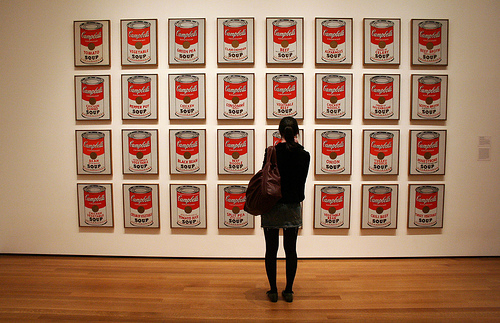
How does a brand catch a customer's interest when their attention span is now less than that of a goldfish? I spent a few seconds Googling to discover the average person's attention span has shrunk since 1998, by 11 minutes.
The average attention span today is 8 seconds
The National Center for Biotechnology Information says our attention span is now 1 second less than goldfish. What hope does a brand have to convince us to buy?
Consider a tube of toothpaste. The average main grocery buyer now spends less than 20 minutes in the supermarket for the big weekly shop. With over 10,000 items to choose from it's not surprising when faced with so many options brands are struggling to catch shoppers' interest. At the dental care section 27% of shoppers walk away without making a decision.
You may be aware Australians have never been better educated, the number of university graduates has almost quadrupled since 1986, from 6% to more than 21%. Are we any smarter or better prepared to make purchase decisions?
We are exposed to five times the quantity of information every day than we received 30 years ago, (you may be surprised just how many ads we are exposed to). Yet we have less free time to consider. The Economist explains that time poverty is a wealth syndrome, the more money we have the more we value our time and the more choices we are confronted with to spend that time. At the other extreme, cash strapped people have largely given up trying to decipher so much information, they are influenced by price like never before.
Price is increasingly winning over brand appeal. It's at the heart of the growing success of ALDI – less items to choose from, mostly unbranded, all at lower prices. This has seen their share of grocery sales reach 10%, a big slice of the market brands are mostly missing.
Even brands are struggling to be seen in Woolworths
According to Woolworths own research "more than a third of the items in Woolworths’ supermarket trolleys are purchased on promotion." That's an increase of 10% a year for the last two years.
"Australians hunting for bargains are the big winners, with one in four customers (25%) purchasing nearly half of the food and drinks in their trolley on special."
How do the retailers manipulate the time poor if not with price?
One journalist recently warned shoppers something brand marketers pay dearly for:
- The most expensive brands, or the ones being promoted heavily, will always be on the two shelves that sit between waist and shoulder height.
- Cheaper products are often stocked below knee height.
- Supermarkets know that you may only want milk so put it at the back of the store in the hope you’ll pick up items you don’t need.
Not only are the retailers asking brands for price rebates, Private Label substitutes are also catching once impregnable brands in a pincer movement. So if you believe in protecting the value of your brand you'll probably want to avoid discounting too often. Only the biggest and most desperate can afford to pay Coles and Woolies to be on promotion. In the past sales managers have encouraged the benefits of putting products on promotion to drive sales. Does it still work in the era of short attention spans?
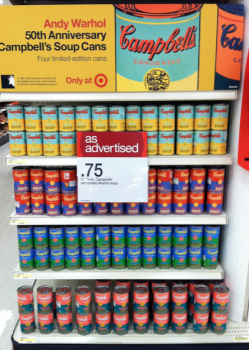
My associates at consumer benchmarking specialists B4P spent a year researching the impact of sales promotions at Point of Purchase (POP). The clients were several of the largest global FMCG companies that are active promoters in Australia's supermarkets, every week of the year. They tested awareness before promotion, cut through in-store, trial, impact on sales and recall several weeks later.
Across all promotion types, (price promotion, competitions, bundled offers and bonuses), shoppers generally don't notice any of it. This is despite multi-million dollar spends on displays, cardboard, posters, banners, gondola ends and shelf strips. Most in-store promotions have become invisible.
Earned and shared media can still gain attention
As we learned over seven years growing Pacific West from a $6million pa frozen seafood minnow to a $38million challenger brand, you can drive shoppers to your product by creating original content to tell your story and social media to spread the word. Just remember your audience has a short attention span. Here is a charming infographic that shows the optimum number of times to post content on social media channels.

Read More
Think big, or detail will kill your business


"Look, I said I'd bring you the report on micromanagement,
just give me a minute!"
Stop sweating the small stuff, especially now there's so much of it. New technologies allow us to gather data on just about everything. So it's become accepted practice for marketers and sales to invest in new ways to gather stats and report to senior management. For those of you wondering what's the point, it has now been proven the more a business spends on technology, CRM systems and sales data, the less well it performs in profitable conversions.
The more technology marketers use, the worse the results
Sounds like a contradiction, but the research undertaken by Peter Strohkorb into sales and marketing collaboration in 2013/4, simply proves the more systems teams add the worse the sales results. It's symptomatic of what the authors of Blue Ocean Strategy postulated over a decade ago. A typical strategic plan is usually based on a plethora of research from silos across the business which forces management to dwell on detail. Management becomes paralyzed by information overload.
The businesses that thrive are the ones that step back and look at the big picture using a customer centric view of what could be possible. Here's how it works.
Focus on the big picture to create a Blue Ocean Strategy
| Head to head competition | Blue Ocean creation | ||
| Industry | Focus on rivals within industry | Looks across alternative industries | |
| Strategic group | Focus on position against competitors | Looks across strategic groups | |
| Buyer group | Focus on better surving current buyers | Redifines who buyers can be | |
| Scope of product /service | Focus on costs/maximising value of current offer | Looks across complementary products/services | |
| Functional/emotional orientation | Focus on price/performance improvement | Rethinks the orientation of the industry | |
| Time | Reacts to industry changes as they happen | Participates in shaping external trends over time |
With a Blue Ocean strategy, you can implement a clear brand building campaign
We've found time and again, once clients re-visit what they can be, the task of growing the business becomes clear. Our methods to help create clear differentiation set the business up for challenger brand growth. With a single minded compelling tag line that sets them apart, big picture thinking helps refresh the business. There is new enthusiasm we harness to recreate the brand and relaunch. The way is now clear to become a price setter, not taker and drive sales conversions.
See some of the ways a refreshed brand can improve profitability.
Read MoreFor a nation of gamblers we're marketing risk averse
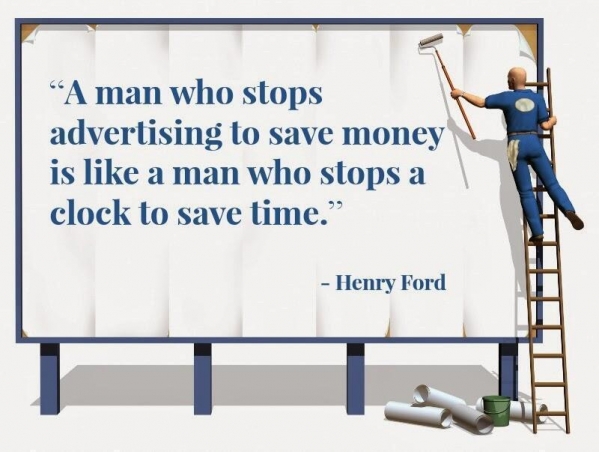
The companies that rated best for effective marketing, according to a recent Gartner study, were the ones that spent the most time understanding their customers. Businesses that are introspective and fearful of action will lose sales to those actively talking to customers and prospects.
How do you guarantee marketing success?
Jan-Patrick Schmitz, CEO of Montblanc North America, says "it obviously starts with the CEO. If he or she doesn’t understand that the business is about the customer and not operations, the CMO is going to have an uphill battle. Understanding your customer is about understanding what your business is and what your business will grow into.”
It's not a lottery, once you understand what customers want from your product or service, marketers that advocate for the customer in the boardroom will win.
Get the message right, then the risks are reduced irrespective of the mediums you then try. If you do understand your customers true needs and what they value most, and built your offer to satisfy those desires, it's time to check out the latest ways to advertise and connect.
Read MoreAussie business struggles, time for a creative way out


Will our kids ever be able to afford to buy a house? Can they even afford to rent? Here in Woolloomooloo 2 bed flats start at $1,000 a week, unfurnished! Unemployment is on the way up, mining investment on the way down. Coles and Woolies continue to squeeze farmers and FMCG brands while bricks and mortar retail is flat.
The big 4 banks are making record profits on higher margins than ever. If you are a small to medium business they probably won't give you a loan. 20 years ago 75% of bank lending was to business, now 75% goes to funding ballooning house prices.
This chart shows the decline in business investment post GFC
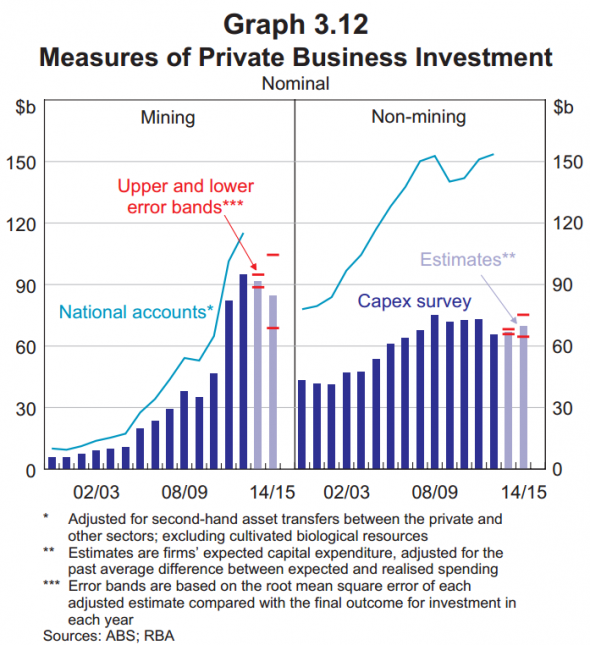
If businesses aren't investing in themselves, how can they grow let alone survive as the Internet destroys traditional business models?
Most managers have spent the last 6 years cutting and seeking efficiencies, hoping if they hang on long enough the market will recover. While local businesses seem to think it's conditions that are tough, World Bank figures show the world is booming – output was up $US75 trillion last year, which is about 20 per cent higher than the pre-GFC peak. 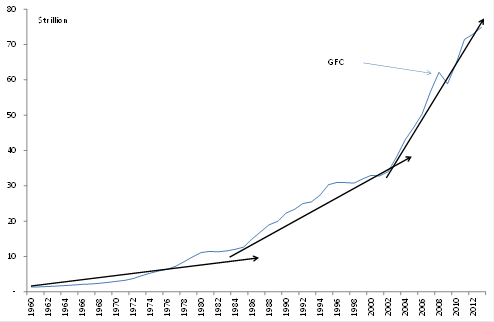
The world is moving on
Australians need to look outwards and recognise there isn't going to be a return to the way things were, the new reality is more rapid change and creative destruction. I use the word creative discerningly. It's the best way to describe the increasingly global competitive situation most businesses are struggling to get their heads around.
Historically change came slowly and could be managed by gradual adjustments of pricing, distribution or inputs. Not any more.
Enabled by the Internet, we now have Google replacing entire distribution channels with a search box. The Cloud has enabled brands such as Xero to offer with a lower cost and better service to leapfrog long established businesses like MYOB that relied on annual software upgrades. Social media has empowered determined consumers to "out" entrenched self-serving business practices, just look at CommBank's conflicted financial advice scandal that could cost it over $100million. (Or ANZ's Timbercorp scam and Macquarie's financial planners rort.)
These are all examples of a new business environment. New challenges require new thinking. A survey of over 300,0000 managers published by Harvard Business Review shows both CEOs and the next 3 levels of management aren't equipped to think outside the square.
The most important skills as rated by managers
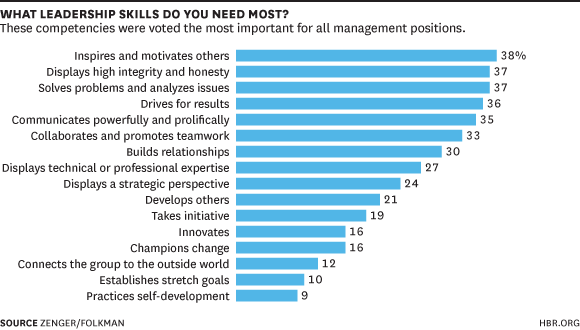
Perhaps the skills that are most needed today to deal with the rapid pace of change are the ones required to find creative ways to refresh and relaunch a business. Yet the survey found these are the least valued by management. Can you imagine how the people behind some of Australia's most successful businesses would rank themselves for the skills on the list? Like the young pair behind Atlassian, ten years ago a start up now worth $3.5billion. Or Boost Juice, Cochlear or Challenger, Seek or Xero. How important to their success are the more creative skills most managers in the survey dismiss?
Creative thinking skills
Innovates
Champions change
Connects the group to the outside world
Establishes stretch goals
Practices self-development
You may be interested to see evidence of how creative thinking adds value in this time of digital disruption. UNO helps challenger brands grow by encouraging and mentoring these creative skills that most managers have underutilised. Download our formula for growing challenger brands here.
UNO's one time client at Choice Christopher Zinn explains more on the new influence of the determined consumer.
Read MoreWant to see where marketing is headed?

Technology is changing everything in our world. Marketing isn't just following the trends, today marketers are actually more likely to be using new technologies to drive change within businesses than the IT department.
I wrote recently that Gartner has found the average CMO now spends more on IT than the CIO. It's all about understanding what the customer wants, then finding what technology can now do to give it to them.
Big Data driven future for marketers
Here is a chart I came across that helps explain where we are today and where we are heading. Sooner rather than later.
Just click for a bigger view of the future of marketing.
Read MoreWant a strong brand? Here's one we prepared earlier
What's in a brand name?
Money in the bank if you choose the right one, or an uphill battle and wasted dollars if you get it wrong.
Your business is your baby, and just like your first child, choosing a name can be fraught. Rather than show stats or a share a list of "most popular brand names of 2014" or cherry picked research to explain the pros and cons of what makes a good brand, I'm going to share 30+ years of trial and error and what it's shown me actually works in the real world. Not just what sounds good when shared with your spouse when working through the choices lying in bed late at night.
How a brand name change delievered a 3000% return
City Mutual had been around for over 100 years, yet onlythan 2 in 100 Australians recognised it. Three years later it was the best known investment and insurance group after AMP, having changed it's name to Capita.
Buying IBM means you won't get fired
Managers for decades have filled tenders, often at higher prices, knowing the board would never question the decision. Every time a client comes to me saying they want to call their business a series of initials they quickly use IBM as an example of why it will work. You can forgive their missunderstanding of what makes a brand. Unless your over 100 years of age you would necessarily know International Business Machines gained it's reputation for deivering reliable and ofte leading edge typewriters and for fifty years before it abreviated it's name to the initials that sat kneatly in the corner of millions of machines in office desks around the world. Today they business is in consulting, so Business Machines wouldn't be apt.
How to make a splash
Local businesses need to think of global consequences
When IFX Markets, a UK listed financial services business wanted to test market a business model in Australia for global roll out, the question of the right name came up very early in discussions.
Read MoreHave Aussies forgotten how to make things?


If you're anything like me, you enjoy a weekend trip to Bunnings. Today there are more things to buy than ever, for less than when our fathers took us to the local hardware decades ago. Where once tools and taps and barrows and bolts were manufactured in Australia, most of this stuff is made in China.
Most of us would agree Australia's manufacturing sector has been destroyed by cheap Chinese imports. What hope is there for Australian made? With the help of some lateral thinking, maybe more than most think.
The end of the made in China boom?
Robert Gottliebsen reports China's remarkable gains in productivity and standards of living were all achieved with borrowed capital and technology. Alan Greenspan points out that no Chinese companies feature on the annual lists of the world's most innovative companies -- nearly half of those lists are made up of American companies. This is leading to a narrowing productivity gap between China and the US, which is putting serious pressure on the Chinese economy.
That's right, don't underestimate the power of first world creative thinking when matched against the cheap cost of third world manual labour. Here are a couple of examples from my dealings over the last year.
Australia leads the world in compression fabric design
 I remember twenty years ago most Australian clothing manufacturers closed their local factories and set up workshops in Fiji where labour was cheap. Now most clothes sold here, even in stores like Zara, are made in China or Pakistan by one suspects slave labour. Yet in some areas of fashion we continue to lead the world.
I remember twenty years ago most Australian clothing manufacturers closed their local factories and set up workshops in Fiji where labour was cheap. Now most clothes sold here, even in stores like Zara, are made in China or Pakistan by one suspects slave labour. Yet in some areas of fashion we continue to lead the world.
Our client Quick Response is a local family business of almost 20 years who are still designing and making swimwear and compression garments locally. What's more, they manufacture using Australian made fabric.
In fact Australian compression fabric is the most technologically advanced in the world. It's the result of research and innovation that over the years has been tried and tested by our champion swimmers in those body hugging suits.
UNO have built an e-commerce site so you can buy the world's-best QRS compression garments direct, for less than sports brands that are usually made in China and Indonesian from inferior fabric.
Still open: a local manufacturer of timber shutters
Thirteen years ago Open Shutters was one of UNO's foundation clients. While cheap Chinese shutters have decimated most local manufacturers, Open continue to do business by concentrating on innovation. An obsession with quality design, investing in advanced machinery and only using sustainable timbers continues set them apart.
While white paint may disguise the compromises of Chinese made shutters in the short term, having been in the market now for several years they are proving to peel, bow, crack and break. The fact Open's product is built to last sees them gaining repeat sales over two decades on. What really makes the biggest difference is the way Open think: 
What truly lifts them to the top of their category in the world is the design thinking process they apply in everything they do. When suppliers tell local architects or designers their ideas aren't possible, Open finds a creative way to deliver.
Could robots save Australian manufacturing
If you still doubt the power of creative thinking over cheap labour, consider this. Last year McKinsey released a list of the things that would change the business world. Near the top of the list was advanced robotics: robots with better and better senses, dexterity and intelligence that can automate tasks or help humans or even operate on us more effectively than... humans.
To quote the numbers:
• 170%: growth in sales of industrial robots 2009-2011,
• 320 million: manufacturing workers (12% of global workforce), and
• $2-3 million: cost of the 250 million annual major surgeries.
Here's what robots could do:
"Advances could make it practical to substitute robots for human labor in more manufacturing tasks, as well as in a growing number of service jobs, such as cleaning and maintenance. This technology could also enable new types of surgical robots."
Closer to home, when I underwent keyhole surgery a few months back, I could have chosen to be operated on by a robot designed in the US for remote controlled surgery on the battlefield. My gap cover wasn't enough to cover the extra cost, but the cost gap will quickly close. It's another reminder the changes in our lives will more likely be shaped by innovation than the global oversupply of cheap labour.
If you are a manufacturer the message is clear, forget cost cutting, start thinking and get marketing.
Read more on how to rethink your business.
Read MorePerception or Reality? Customers now decide


Over 50% of people don’t trust financial advisers. So I was told on the news last night. If you have ever been to see an advisor you’ve probably come away with the perception that they aren’t telling you everything straight. Commbank’s multi-million dollar financial planning scandal has proved perception IS reality when it comes to advisors.
For decades when a business advertises a product, whether baked beans or an investment, the words and claims made are open to scrutiny and have to be THE TRUTH. You have to deliver on the promise or you are liable under a number of ad standards, ASIC and ACCC rules. If you sell a financial product face-to-face most of these rules don’t seem to apply or be enforced.
Big 4 Banks still traditional marketers
What the big 4 banks and AMP have got away with is a classic exercise in traditional marketing methodology – control the distribution channel and you control both pricing and product. By using different brands they have been able to sell the same products to an unsuspecting public. Most people haven't realised 80% of advisors work for groups owned or aligned with just 5 product providers.
Most people think they are seeking financial advice, when what they are getting is a sales pitch. How can anyone be given genuine choice when of 18,000 advisors only 31 are truly independent? We’ve all been buying Home Brand super for years and haven’t known it. Here is a list of just some of the hundreds of “brands” just 5 providers have sold their own products under:
Cavendish AMP
Charter Financial Planning AMP
Garrisons AMP
Genesys AMP
Hillross Financial Planning AMP
Ipac AMP
Avanteos Commonwealth Bank
Colonial First State Commonwealth Bank
Commonwealth Financial Planning Commonwealth Bank
Count Financial Commonwealth Bank
Financial Wisdom Commonwealth Bank
Witaker McNaught Commonwealth Bank
Apogee NAB
Garvan Financial Planning NAB
Godfrey Pembroke NAB
Lend Lease Financial Planning NAB
Meritum Financial NAB
MLC NAB
Elders Financial Planning ANZ
Financial Services Partners ANZ
Millenium3 ANZ
OnePath ANZ
RI Advice (RetireInvest) ANZ
Sentry ANZ
Asgard Westpac
BT Westpac
Pact Accountants Investment Group Westpac
KPMG Financial Planning Westpac
Securitor Financial Group Westpac
A couple of rogue CommBank advisors who ripped off investors for millions is just the tip of the iceberg of poor brand values. Ian Narev says the business won’t suffer. I suggest the era of brand equity built upon decades of million dollar perception-shaping advertising is over. The Internet has democratised the share of mind of customers. Does Narev not understand this? Instead of changing his business model he returned from holidays to push the button on a million+ dollar ad campaign trying to reassure customers they are fixing things. This old school reaction won't preserve brand equity long term. Here’s proof.
Try Googling CommBank financial planner. This is the result I got:
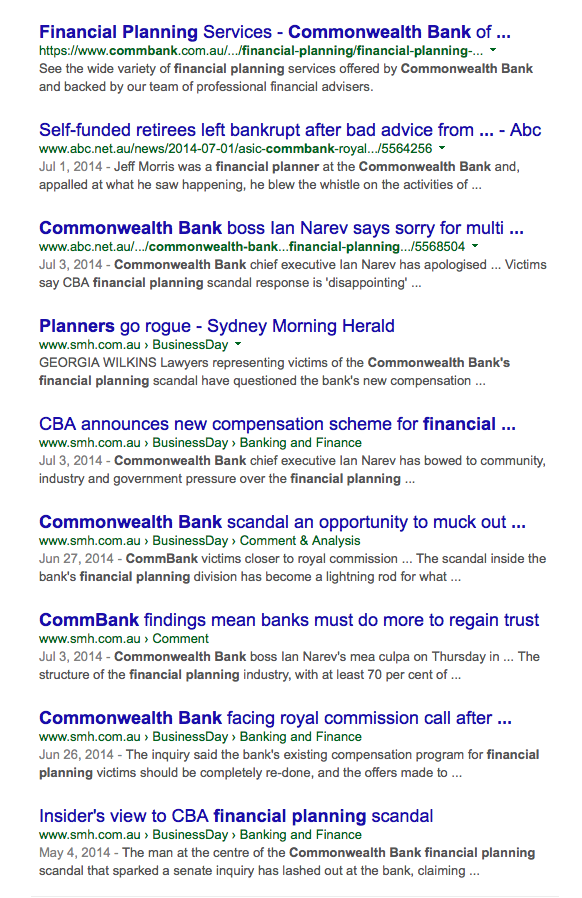
Last week we saw the government roll back the FoFA laws that were supposed to make hidden and trailing commissions illegal. Despite some wordy amendments from Clive Palmer, there is still no ironclad law that insists advisors can’t sell you a product because they get a kickback, not because it’s the very best choice for you.
Challenger brands will win with customer centric marketing
Legislation may not stop the consumer unfriendly practices of big banks. Social media and the empowered consumer will. And new technologies will see challenger brands that build financial product and service offers around what customers actually want will grow at their expense. Coles new deal with GE Capital to offer loans is just the start. I'll leave the last word to a consumer active on social media:
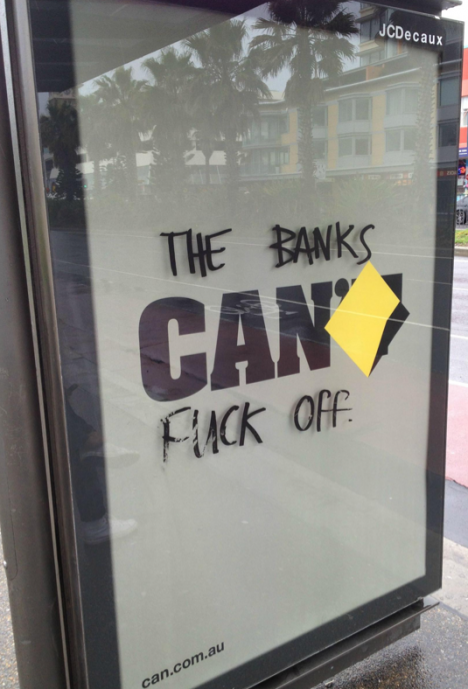
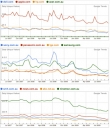
One of my clients attended a Social Media Marketing forum at Deakin University recently. He was surprised just how out of touch most marketing and business managers are with this medium as a means for promoting a business. The questions being asked were about how to control staff access to social media or how to post their brands’ advertising and collateral across the newer platforms.
This top down approach where management dictates the agenda no longer cuts it.
In the same way the Internet has empowered the public to access their news, music and entertainment whenever they want, not when the distributers choose to roll it out, Social Media is taking the online quest for information about products and services away from publishing and brand sites. Social Media is creating a vibrant forum for conversation about products, services and brands beyond the direct control of a company’s sales and marketing force.
The statistics show the rapid pace of change of where people are going online in search of information of all kinds.
Trend away from website visitation to Social Web
Google trends show over the last 2 years a significant decline in visitors to brand and media sites.

Boom in Social Media and content sharing
More people are seeking and sharing what they want online.

It’s no longer enough to have a brochure style website, you can no longer sit back while your salesforce distributes your marketing collateral and your marketing department runs ads telling the masses how good you are.
Everyone in your organisation and every one of your customers is now a prospective advocate for your business. Or they might be saying your competitors are better. You can’t control the conversation, but to compete today you need to formulate a social media strategy, coach your staff, create content of use to customers and prospects and contribute to the conversation in an open and honest way.
Small can succeed in retail against big budget incumbents
Growing up in sixties suburban Sydney the most exotic cuisine my family was familiar with was cabanossi on Jatz crackers. Father felt like a Tooheys or two and good on my mum, she knew Tip Top was the one. Fortunately, forty years of immigrant mothers from around the globe have helped expand Australians’ culinary horizons.
Family businesses show how to be a challenger brand
At the Food and Wine Expo held by Family Business Australia in Sydney in November, the influence of Nonnas was evident as third generation business owners showcased their gourmet products. Their time has come, statistics show the trend to gourmetisation of the Australian shopping basket has now reached beyond the specialist deli and ethnic store to the Supermarket.
Unlike most trade shows, what struck me at the FBA event was the friendly atmosphere, no hard sell, just an infectious enthusiasm for the products these families have been creating for years and a desire to share business stories. From the small catering company making their first tentative step into retail, through to a food service business that gave up on retail in the 70s, one story is common: the bigger challenge isn’t getting onto the shelves of Coles and Woolworths, it’s how to stay there and make a profit.
Two family businesses, Taylors Wines and Coopers Brewery, are testament to the magic ingredient for success in the retail market – the power of building a brand. Branding is what puts the power in your hands, not the channel’s. Building a brand takes more than one-off promotions, or advertising that simply says you are in store now, or paying for inclusion in catalogues with discount offers. To build a brand you need to invest in marketing over time to establish the brand story and your values.
Brand marketing delivers these benefits over a me-to sales approach:
Product
Easy to copy
A commodity
No special distinguishing features
What a factory produces
Shorter life cycle
Addresses functional needs
No identity
Products compete on price
Brand
Hard to copy
What consumers buy
Emotional fit with consumers
Level of confidence and trust
Longer life cycle
Addresses emotional needs
Have personalities
Brand can demand a premium
Fosters Group has destroyed shareholder value to the tune of hundreds of millions of dollars over the last decade by mismanaging the marketing of some icon wine brands, from Lindemans and Penfolds to Seppelt and Tollana. Meanwhile, family business Taylors Wines has stayed true to its five decade history with consistent product, packaging and promotion.
Nick Levy, the marketing manager at Taylors, wouldn’t dream of throwing out the heritage of this family business, whereas corporations time and again allow each new brand manager to make their mark by changing the label their customers know and love to chase a fleeting fashion. Often the new look comes at the expense of long won recognition. Similarly, downgrading a product’s quality to maintain margin or constantly price-cutting to gain share ultimately destroys brands.
Yes, we live in a time where the pace of change is so much faster, yet taking the time to establish what you stand for, developing a dialogue with your customers and creating a sense of authenticity are increasingly valuable tools in a world where global producers can pitch to your retailer with a cheaper knock off product as soon as you leave the buyer’s office.
If you value what you have to sell, it pays to remind your customers as often as you can of why they should love you. Now you can afford to. New technologies, data intelligence and eCommunications now enable challenger brands to compete successfully with the large advertising budgets of corporations.
So find the true benefit of your offer and actively market it. As Revlon said, having built an empire with brand marketing, “we don’t sell cosmetics, we sell hope.” Worked on my mum.
This article first appeared in Business Insight
Leave traditional marketing to your competition... Now there are smarter ways to connect

To make the most of a marketing budget there are now smarter ways to integrate social media and search optimisation.
Many struggle to keep abreast of the changing landscape, while companies that take advantage of 'eCommunication' will benefit from increased efficiencies, decreased costs and improved customer engagement.
Traditional marketing funnel view of prospects...

Medium and message is aligned to where the audience is in the funnel, information is controlled by the brand.
The decision making process in an e-connected era...
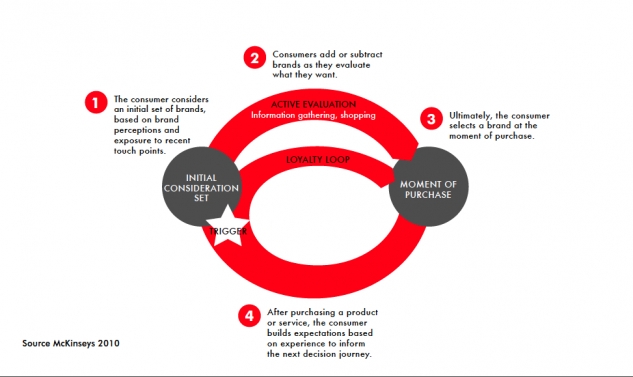
Time to replace the old touchpoints with a new mix
The journey is no longer simply linear, the customer now has control over what they see and read on any subject. The audience enters, leaves and re-enters the decision making process more often, with more access to information from more sources when they want it.
Your eCommunications checklist
Whether your business is B2B or B2C, it’s no longer enough to think in the linear way of out of home, in store (channel), at home. Here is a new set of options which UNO utilise to supersede or integrate with existing programs:

Are you a retailer or publisher, advertiser or educator? The Internet has blurred the lines.
There used to be clear delineations between product manufacturer/creator, channel/distributor, retailer and end consumer.
Enabling this traditional marketing model there was mass media. Advertising mad men then helped consumers to embrace the products and services they hadn’t heard of and didn’t know they needed. Now the interconnections of the Internet have transformed the sequence of commerce and marketing.
Customers are now researching every category online
People have a need? They research online for themselves in the safety of their own home, avoiding the charms of advertisers and brand collateral, packaging and point of sale merchandising. The empowered consumer accessing product knowledge on the web via forums, chatrooms and reviews is beyond the charms of the seasoned salesman on the shop floor.
Even more disconcerting for the traditional retailer of a product or service is the emergence of the medium no longer just being the message, but now a vertically integrated marketing model.
From books to money management, every category has been turned inside out and upside down. What was linear, is now a 3D demand and supply freeform organism.
Consider books. A hard back would come out, early adopters would pay a hefty premium, soft cover would follow, trends would be noted, popular titles would have second and third editions printed and distributed, blockbusters would be advertised and the retailers would rake in the cash and the publishers would cover the costs of the many failures by most of their authors.
Then Amazon cut out the middleman, and now with the Kindle is changing the distance from content to delivery even further, you can now download and store a library of 3500 “books” on a device that is close to the price of a couple of hardbacks. So if there is no need to print and distribute, does the author deal direct with Amazon, seeing the retailer become the publisher?
Even services aren’t untouched by the digital revolution
Take for example Superannuation Funds. If you work you have one, no wonder there are thousands of funds competing for a share of 9% of your salary.
For Australian investors there used to be 3 Clayton’s choices, the choice you have when you don’t get a choice. If you were a blue-collar worker your employer put you into the Industry Super Fund that was created for your industry. If you were a public servant, you were automatically in your government fund. White-collar workers had a modicum of choice, the local Insurance salesman would flog a retail fund and benefit from the handsome commission and trailing fees.
Not any more. Super Choice means most can now choose their fund. Those who are motivated research online, in fact 50.6% do, whereas only 12% turn to newspapers and a mere 3% magazines. So while all those funds are spending hundreds of millions advertising in mass media, savvy investors that are shopping around are stumbling upon a vertically integrated model. Fairfax Digital owns InvestSmart, a licensed financial services business that bought Direct Access, which was a discount retailer of funds. Fairfax in its wealth and business sections publishes articles on super and investment. On the same pages are links and comparison tools branded InvestSmart. These tools and tips and comparison lists educate the Super Shopper. Then when they are ready to buy, fulfillment is just one click away for a fee a fraction of the traditional adviser model. So the publisher becomes the retailer.
So does all of this mean consumers are better off? The fastest growing and the biggest segment by value of the 1.4 trillion dollar Super category is DIY. Self Managed Super offers investors the allure of control. Pity the average SMSF underperforms the average Industry Fund and has higher costs, until someone challenges the model that is.
Whether you are a retailer or a service provider, a financial services business or a manufacturer, it’s now time to reappraise your marketing model before your competition beats you to it.
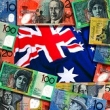
Marketers have spent the last decade watching Woolworths maintain dominance in grocery while Coles failed to focus on customer needs and treated suppliers with disdain. Under Wesfarmers things are starting to change, yet the biggest fight in retail over the next decade is more likely to be driven by a huge shift to buying online.

While Australia’s Westfield has over 30 years fine-tuned a profitable model to encourage a visit to the Mall, as therapy for the modern empty soul, the Internet is on the cusp of changing the behaviour of society in an equally profound way.
It’s already happening. In 2009 Australians spent $24billion on retail online according to research commissioned by eBay and predicts a 40 percent increase to $32.8billion in 2012.
Australia’s retailers are falling behind the rest of the world in grabbing a share of the online retail spend. "As Australian retailers struggle to build effective online presence, overseas competitors are taking advantage of the gap in the Australian market and are currently taking around 40 per cent of Australia's online retail spend," according to PayPal MD Paul Feller.
"There is a huge opportunity for retailers to capitalise on the growing online marketplace in Australia. In the last six months alone the average consumer spent $1,223 on online shopping, an increase of $130 from the second half of 2009."
So Westfield has to balance an online strategy with keeping footfall high in the malls to keep those retail tenants in biz. No easy task, now that broadband speeds and speed and reliability of delivery through the mail are narrowing the gap between online purchase and the wardrobe.
Who shops online?
My daughter buys most of her clothes online from the US and UK for a fraction of local prices, my son buys his music and sound gear from all corners of the world and Amazon keeps my partner well read. Online purchases of all sorts of items will become the norm, especially as the ways to enhance the shopping experience online grow.
In the past you would see the latest fashions in a magazine spread, be exposed to an ad on TV with Megan Gale for David Jones and go the mall to try it on. Now the whole experience can be completed online. The Ceros platform is being used by the likes of Sears, Tesco, Virgin and IKEA to show product and close a sale using a rich media eMagazine. Have a look. We’re already using it to help our challenger brand clients leave their competition behind.
Read MoreMarketing tips for fund managers
Fund managers can make more money by marketing. The trick is to know what marketing is exactly...
I have a passion for following fund managers’ performance and comparing how they stack up against their investment philosophies. There are a handful of fund managers who stick by their principles and deliver above average results through the ups and downs of the markets. What surprises many managers is that investment doesn’t always come flooding their way when they are doing better than the index. There are plenty of examples where poor performing funds continue to dominate in the competition for FUM.
It’s not enough to rely on BDMs and the distribution and sales channels; every fund is out there building relationships with the instos and advisers. The commercial reality is rooted in human nature; ultimately the salesmen who managers are relying on to recommend a fund will go for the easy sell. And as we’ve seen, performance can’t be the only draw card or there wouldn’t be 19,500 funds on the market where the biggest generally aren’t the best. It would be a mistake to think the end of commissions will result in a rush to quality, inertia and confusion will see to that.
It’s time the better managers tried something new to most in the industry. It’s what’s been honed and crafted by the world’s most successful companies, from Apple to Armani, Mercedes to Mars: it’s marketing. In a world of multiple choices, marketing is one of the few tools that can make a significant contribution to the success of a business.
The financial services industry still confuses sales and distribution for marketing
It isn’t. Marketing takes the ball the first fifty metres and sales kick the goal. Then it’s marketing that continues to remind investors why they made the right decision choosing your fund, so they’ll stick by you through the inevitable bumps and falls. And invest with you again and again.
In the words of Wikipedia, marketing is the process by which companies determine what products or services may be of interest to customers, and the strategy to use in sales, communications and business development. It is an integrated process through which companies create value for customers and build strong customer relationships in order to capture value from customers in return.
Manage the image you create for your brand and how you promote it
From product design and the language you use, your logo and stationery, the look and imagery in brochures and PDSs, the content and design of e-newsletters, what is on your website and how it is presented, to advertising and sales collateral. When every part is working together in a co-ordinated fashion the whole adds far more value to the business than the investment in the parts. And just like investments, managed well marketing delivers compound returns.
Over the years I’ve found integrated marketing works just as well for financial institutions as it does for baked beans. Research by the School of Management and Finance, University of Nottingham showed back in 1998 the similarities emerging even then between consumers’ responses to financial services ads which featured the same cues as ads for fast-moving consumer goods (FMCG) and the influence on subsequent purchase decisions.
Put simply, when it comes to proven ways to make money, fund managers can get a healthy ROI from marketing. For evidence, they just have to ask about the results of my many marketing experiences of 30 years, from banks to baked beans.
Signs of the times... who has the time?
Outdoor advertising is diminishing in effectiveness, like many traditional mediums
Not surprising when you think about the increasing clutter advertising billboards have to compete with for attention.
In the Drive section of the SMH the other day one motoring journo observed: “I went to a suburban shopping district and counted 19 road signs clustered around the first intersection. There were 55 road information messages in about 100 metres. Even when travelling at 40km/h you are left with just nine seconds to read them". In the book Traffic, Tom Vanderbilt states the average driver must process 1340 pieces of information every minute.
So recently when a client asked UNO to review their annual advertising media budget we weren’t too keen to recommend continuing to spend several hundred thousand dollars for one poster above the M4.
Old habits die-hard, the CEO drives to work each day and passes that one sign. We couldn’t convince management that for about 20% of the cost of that one sign they could develop an ongoing relationship with their customers using the latest Web2.0 technologies and build a valuable database for future use.
While traditional media companies like Eye Corp continue to sell posters, a medium that hasn’t changed for a couple of centuries, newer more effective alternatives are emerging. (When the price is right.) ROI marketing starts with understanding the real stats.
Innovation in signage
Recently Ryan Simpson of Val Morgan showed me the latest research on their innovative take on signage, large video screens in shopping centres.
While I always take statistics with a grain of salt, the figures reflect the relationship between clutter and proximity to where the purchase can be made. Despite the amount of billboards, busbacks and taxibacks that shoppers must have passed on their way to the shops, almost 50% say they didn’t notice any advertising. 30% remembered noticing billboards, whereas this new moving screen medium within shopping centres was noticed by over 70% of the 1,000 people surveyed by Nielsen research.
Pity I didn’t have those sorts of stats on hand when I tried to talk that client out of spending a large chunk of their budget on that one sign.
Bigger ad budgets usually mean greater waste
Marketers don't always get what they pay for. I recently met with the new regional head of one to one marketing of a world leading brand. One to one is their fancy term for online. This new manager has been brought in from the USA to determine how the millions of dollars they spend annually in this region can deliver a better return.
Mid size companies can learn from the mistakes of larger marketers with larger budgets. Some of the areas of waste this expert has identified in just a few months are listed here:
Marketing budgets managed within silos is inefficient
Some products have budgets too small to make any impact, while others spend more than necessary because they have a larger allocation. Simply by adding an overview of expenditure across the portfolio would deliver a win win result.
Too many contracts with too many large agencies can drive a big spending approach. Marketing managers with little experience are often given average strategic advice and average creative executions. Large agencies are inclined to overspend on media exposure, (with commissions it's an easy earn).
Set marketing KPIs upfront
Smarter marketers know investing in more management time upfront determining objectives and KPIs, with strategic intellect and strong creative can mean a much smaller media spend can deliver greater impact, more leads and higher conversion rates. There is also an inevitable diminishing return factor from spending more, if someone sees your ad two or three times and still hasn't bought, spending more to show them the same proposition four or five times is simply a waste of money.
There is value in retained knowledge
Years of collected data, research results, campaign learnings and customer databases are often ignored with each new project. Every campaign can and should add incremental value to the next. Take a test and learn approach, rather than a big spending one-off hit. This is one of the fastest ways to implement ROI marketing.
Fortunately for my mid sized clients, I've found over the years insight led creative marketing can punch above it's media weight time and again.
Read MoreGM a victim of launch and leave
For General Motors, big has not proven to be better. From 50% market share to 20% and bankruptcy in just 40 years has partly been blamed on an inability of management to move with the shift from big gas guzzlers to smaller cars. The disastrous purchase of Hummer in 1999 showed how recently GM thought big still had a big future. Time has proven there were only a few big spenders like Renee Rivkin who bought these massive buckets of bolts, obviously not enough to pay the massive borrowing costs.
Less obvious to the public, and of more interest to marketers, are the views being expressed that a lack of advertising support has played a very significant role in the rapid market share loss to the Japanese car makers.
One example was the surprisingly upbeat statements by the head of marketing of GM, he is excited by the prospect of having less brands to support with his marketing budget. With the jettisoning of divisions like Pontiac, he'll be left with just four brands to promote, including Chevrolette and Cadillac. This he trumpets will give him a chance to compete with the same ad budget as Toyota.
In an obituary of the once market leading General Motors, The New York Times blames management for a failure to support it's product with advertising.
Advertising works, The New York Times says so
It points out GM finance staff wrestled with product developers and marketers, thus causing GM to fall victim to a practice called launch and leave - that is, putting product on the market, then failing to support them with advertising.
As someone who has played a part in helping numerous businesses grow share by using smart, creative advertising, this is a particularly public example of the consequences of not believing in the power of marketing. If you ever have to justify to management the wisdom of investing in advertising, when so many accountants seem to view it as a discretionary cost, use this following quote from a past executive of GM who was part of the team that created the successful Pontiac GTO in the 60s and wrote the book about it Glory Days...
Image is everything in building brand equity
Nobody gave any respect to this thing called image, because it wasn't in the business plan. It was about "when is it going to earn a profit?"
As the New York Times points out, over the years the marketing skeptics at GM became practiced at the art of explaining their problems, attributing blame to everyone but themselves.
Read MoreIt pays to trust people with passion
In the last week a visit from a chimney sweep and a conversation with a successful Australian manufacturer reminded me of the value of passion in business.
I was surprised when the chimney sweep asked when was the last time my chimney had been cleaned. Annually didn’t make sense to him judging by what he saw with his fancy mirror... unless I burn 20 tonnes of wood a year, which I don’t. I was quickly impressed by his enthusiastic run down on the finer points of proper chimney maintenance. This man has been cleaning chimneys for 27 years and was still getting a buzz from helping people solve their dirty flue problems, he described the joy solving more difficult challenges and leaving customers with fires that draw like new. His fee was no more than the company that has under serviced us over the last few years.
Whatever service you need, find a practitioner who is passionate about what they do
One of my long standing clients, going on nine years now, makes plantation shutters. Marion Mikkelsen of Open Shutters is passionate about her product, and has built a brand over this time that has proven resilient against the onslaught of cheap Chinese imports. She is so passionate every aspect of her business is constantly reviewed with the objective of constant improvement. She refuses to compromise, so instead of cutting corners to save costs this business runs on a successful program of creative thinking, R&D, staff training and manufacturing innovation.
This passion shows in her product, which my wife thought was the best when she did her pre-purchase research for our home. It was only a few years later I coincidentally won Marion as a client... it is great to be able to market a product you’ve bought yourself.
Why do so many business people mistrust each other?
Over 20 years this pioneer of timber shutters in Australia has led with product innovation and with UNO’s marketing help driven the growth of the category. Yet Marion lamented this week how it’s only after many years her distributors are beginning to trust what she says about her product and her overarching belief in the necessity to fulfill the expectations of consumers. How could so many small business owners not recognise the genuine passion displayed by Marion?
I shouldn’t be surprised, I often find business prospects are cynical of what I have to say about how smart marketing can help their businesses succeed. I’m passionate about what I can do to help people, however it’s even harder to be believed when I work in an industry that the public constantly ranks at the bottom of the trust table alongside used car sales and real estate agents.
Read More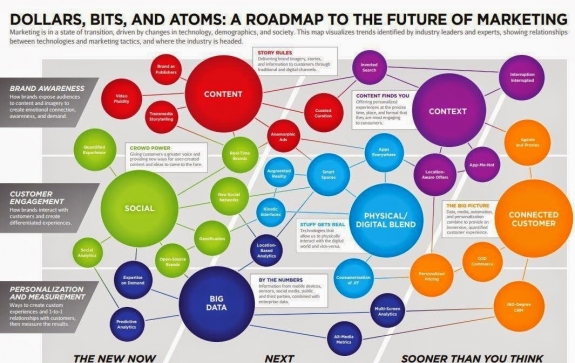



Scan the QR code for our contact details.
Download the Neoreader app.
© COPYRIGHT 2013 UNO marcomms Privacy